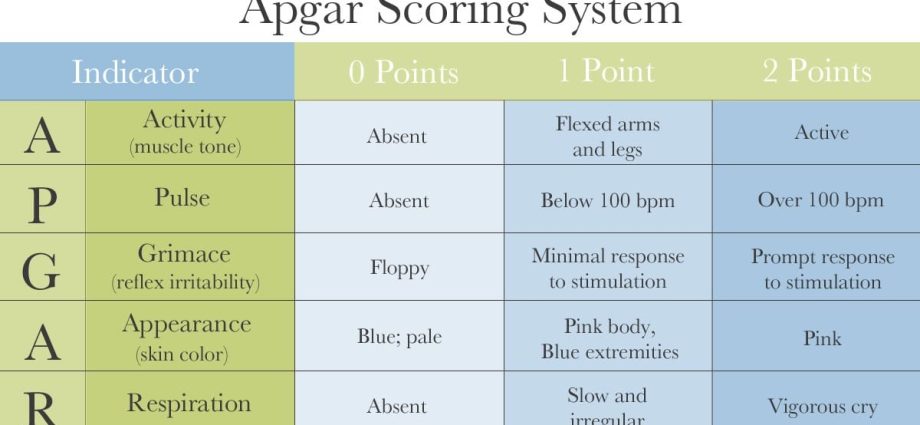In order to enable doctors to assess the vital functions of the newborn, the Apgar scale was proposed in 1952. The Apgar scale is named after an American physician, specialist in pediatrics and anesthesia, Virginia Apgar. The acronym, created much later, in 1962, defines five parameters to which a newborn is subjected. What do these parameters refer to?
What does the Apgar scale determine?
First: Apgar scale is an acronym derived from the English words: appearance, pulse, grimach, activity, respiration. They mean in turn: skin color, pulse, reaction to stimuli, muscle tension and breathing. The scale of points obtained in relation to one feature is from 0 to 2. In what situations will the child receive 0 and when 2 points? Let’s start from the beginning.
Skin color: 0 points – cyanosis of the whole body; 1 point – cyanosis of the distal limbs, pink torso; 2 points – whole body pink.
Pulse: 0 points – pulse not felt; 1 point – pulse less than 100 beats per minute; 2 points – pulse of more than 100 beats per minute.
Reaction to stimuli subject to two tests, during which the doctor inserts a catheter into the nose and irritates the soles of the feet: 0 points – means no reaction to both the insertion of the catheter and irritation of the feet; 1 point – facial expression in the first case, slight foot movement in the second; 2 points – sneezing or coughing after insertion of the catheter, crying when the soles are irritated.
Muscle tension: 0 points – the body of the newborn is flaccid, the muscles do not show any tension; 1 point – the child’s limbs are bent, muscle tension is minimal; 2 points – the child makes independent movements and the muscles are properly tense.
Respiration: 0 points – the child is not breathing; 1 point – breathing is slow and uneven; 2 points – the newborn cries loudly.
8 – 10 points means that the child is in good condition; 4 – 7 points average; 3 points or less means your newborn baby needs immediate medical attention.
Study using a scale apgarto make it meaningful, performed:
- twice: in the first and fifth minute of life – in newborns born in good condition (who received 8-10 Apgar points).
- four times: in the first, third, fifth and tenth minutes of life – in newborns born in a mediocre (4-7 Apgar points) and severe (0-3 Apgar points) condition.
Repeating the test Apgar scale it is important as the child’s health may improve, but unfortunately it may also deteriorate.
Why is Apgar Scale Assessment so important?
method scali Apgar it is effective because it allows you to define the basics child health parameters. However, one of the first activities of a newborn baby assessed by an obstetrician is whether the baby is showing proper breathing. Is it even, regular, regular? This is very important because a newborn baby leaves its mother’s body in a world that is completely new to it. It is a shock to him, so one of the first reactions is screaming. This allows the doctor to know that the newborn is breathing. Evaluation follows regularity of breathing. If it is not normal, oxygen is required. Premature babies are very often affected by irregular breathing. This is because the lungs have not yet developed properly. Such children then do not receive the maximum of points in scali Apgar.
Normal heart work it is also an extremely important factor in assessing a child’s health. The physiological heart rate should be above 100 beats per minute. A significant drop in pulse rate (below 60-70 beats per minute) is a signal for the doctor to perform resuscitation.
As for skin discoloration, it should be noted that children born by force of nature may be paler than newborns whose mothers underwent caesarean section. However, it is for this very reason that the test is performed Apgar scale up to four times – the child’s health may change from minute to minute.
A healthy toddler should show adequate muscle tone and show resistance to straightening the limbs. If this is not the case, it may indicate a disturbance in the nervous system or insufficient oxygenation of the newborn’s body. Muscle laxity can also indicate a disease that has not been detected in the womb. According scali Apgar a child who coughs or sneezes after inserting a catheter into his nose shows normal physiological reactions and can receive the maximum number of points for this parameter.










